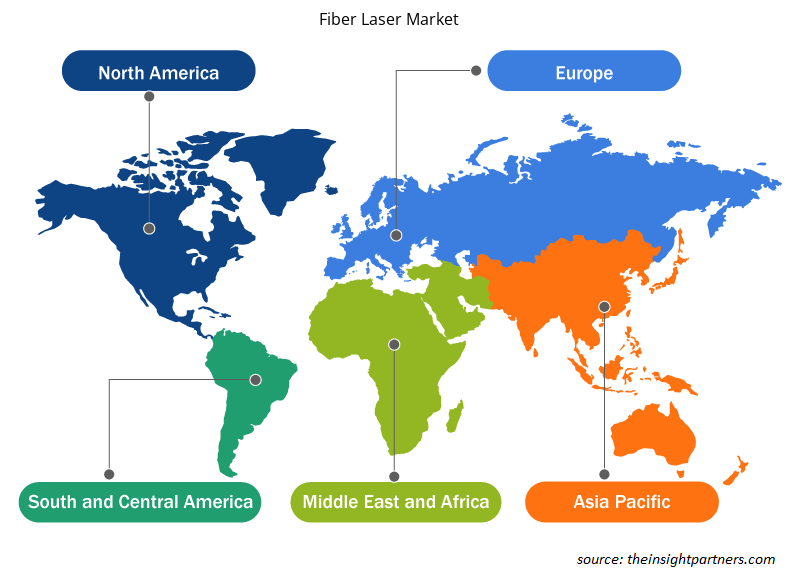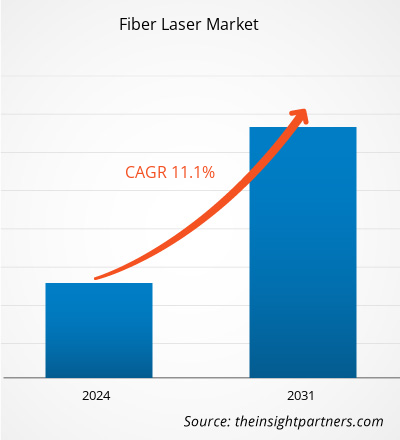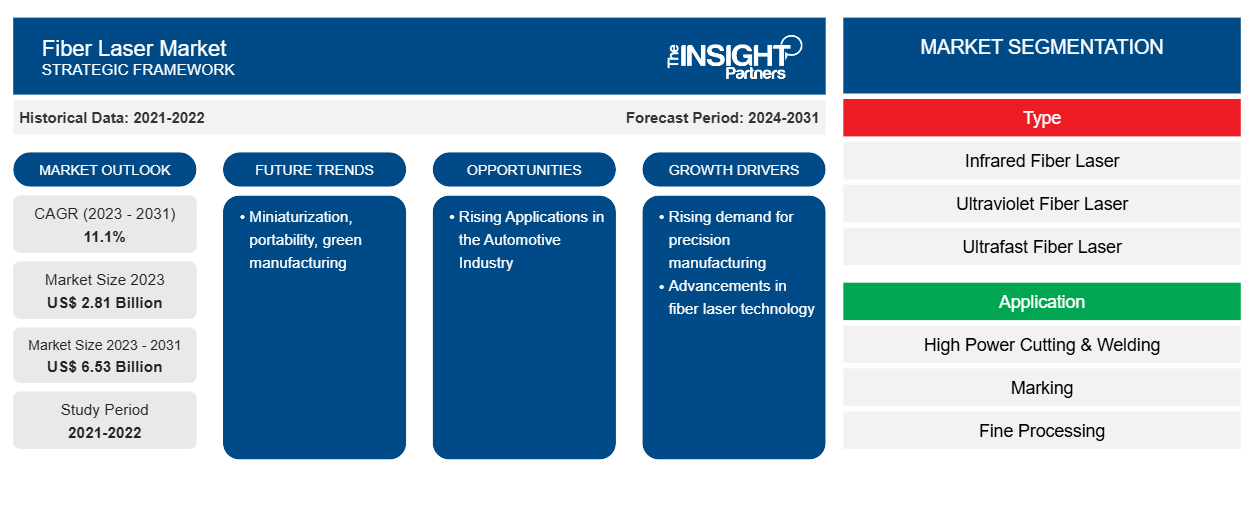光纤激光器市场规模预计将从 2023 年的 28.1 亿美元增至 2031 年的 65.3 亿美元。预计 2023-2031 年期间市场复合年增长率将达到 11.1%。小型化、便携性和绿色制造可能仍是市场的主要趋势。
光纤激光器市场分析
超硬材料切割机的应用正在半导体和电子、采矿和国防等多个行业中不断扩大。超硬切割机集成了光纤激光器等尖端技术,使之成为可能。随着产品开发和市场竞争力的增强,光纤激光器技术的价格下降,预计会受到极大的青睐。光纤激光器技术被认为比电火花机快大约三十倍。
光纤激光器市场概览
在当今世界,光纤激光器被广泛使用。由于它们可以产生各种波长,因此它们经常用于工业环境中进行切割、标记、焊接、清洁、纹理化、钻孔和许多其他任务。它们还用于其他行业,包括医疗保健和电信。光纤激光器在制造业中有许多应用。维护要求低甚至无需维护的连续光纤激光器非常适合效率和速度特别重要的特定重工业应用。例如,连续激光器非常适合激光切割、激光钻孔和激光焊接。脉冲光纤激光器是复杂形状的高度专业化切割的理想工具。此类应用正在推动市场增长。
定制此报告以满足您的需求
您可以免费定制任何报告,包括本报告的部分内容、国家级分析、Excel 数据包,以及为初创企业和大学提供优惠和折扣
-
获取此报告的关键市场趋势。这个免费样品将包括数据分析,从市场趋势到估计和预测。
光纤激光器市场驱动因素和机遇
精密制造需求上升利好市场
精细特征微加工如今已成为消费电子、医疗设备和汽车等各种行业大批量制造的关键组成部分。相反,光纤激光器已成为激光打标和宏处理的行业标准。激光切割改变了制造业的格局,为企业提供了更大的灵活性、速度和精度。随着技术的不断进步,激光切割预计将在未来对制造和创新产生更大的影响。
汽车行业中日益增多的应用
在进行精确、高质量的切割方面,汽车行业普遍认为使用激光切割机是有效的。使用激光切割机可以快速有效地切割多种材料。这可以缩短制造时间并降低成本。此外,它们比传统切割技术更均匀、更准确,从而可以减少成品中的错误和瑕疵。由于精确切割可以有效利用原材料,因此使用激光切割机也有助于最大限度地减少材料浪费。由于体积小,光纤激光切割机可以轻松集成到当前的生产流程中,占用的占地面积更小。
光纤激光器市场报告细分分析
有助于得出光纤激光器市场分析的关键部分是类型和应用。
- 根据类型,光纤激光器市场分为红外光纤激光器、紫外光纤激光器、超快光纤激光器和可见光纤激光器。红外光纤激光器领域在 2023 年占据最大份额。
- 根据应用,市场分为高功率切割和焊接、标记、精细加工和微加工。
光纤激光器市场份额(按地区)分析
光纤激光器市场报告的地理范围主要分为五个区域:北美、亚太、欧洲、中东和非洲、南美和中美。
2023 年,亚太地区在光纤激光器市场占有相当大的份额。该地区拥有重要的制造业中心和成熟的汽车工业。光纤激光器在这些行业的精密制造中占有重要地位,从而推动了该地区的增长。
光纤激光器市场区域洞察
Insight Partners 的分析师已详尽解释了预测期内影响光纤激光器市场的区域趋势和因素。本节还讨论了北美、欧洲、亚太地区、中东和非洲以及南美和中美洲的光纤激光器市场细分和地理位置。

- 获取光纤激光器市场的区域特定数据
光纤激光器市场报告范围
| 报告属性 | 细节 |
|---|---|
| 2023 年的市场规模 | 28.1亿美元 |
| 2031 年市场规模 | 65.3亿美元 |
| 全球复合年增长率(2023 - 2031) | 11.1% |
| 史料 | 2021-2022 |
| 预测期 | 2024-2031 |
| 涵盖的领域 |
按类型
|
| 覆盖地区和国家 |
北美
|
| 市场领导者和主要公司简介 |
|
光纤激光器市场参与者密度:了解其对业务动态的影响
光纤激光器市场正在快速增长,这得益于终端用户需求的不断增长,而这些需求又源于消费者偏好的不断变化、技术进步以及对产品优势的认识不断提高等因素。随着需求的增加,企业正在扩大其产品范围,进行创新以满足消费者的需求,并利用新兴趋势,从而进一步推动市场增长。
市场参与者密度是指在特定市场或行业内运营的企业或公司的分布情况。它表明在给定市场空间中,相对于其规模或总市场价值,有多少竞争对手(市场参与者)存在。
在光纤激光器市场运营的主要公司有:
- 活性纤维系统有限公司
- IPG Photonics 公司
- 藤仓有限公司
- 汇聚光子学
- 相干公司
- 耶拿公司
免责声明:上面列出的公司没有按照任何特定顺序排列。

- 了解光纤激光器市场主要参与者概况
光纤激光器市场新闻和最新发展
光纤激光器市场通过收集一手和二手研究后的定性和定量数据进行评估,其中包括重要的公司出版物、协会数据和数据库。光纤激光器市场的一些发展情况如下:
- 高科技公司 TRUMPF 收购了 Active Fiber Systems GmbH (AFS) 80% 的股份,该公司位于德国耶拿,专门从事光纤激光器。AFS 开发和制造主要用于科学和研究的超短脉冲激光系统和光纤激光系统。除了基础研究外,其应用领域还包括产生具有高相干性的极短波长光、生物医学成像和材料加工。(来源:TRUMPF,新闻稿,2022 年 2 月)
- 全球光纤激光技术领导者 IPG Photonics Corporation (NASDAQ: IPGP) 将于 2023 年 9 月 12 日至 14 日在美国密歇根州诺维举行的电池展上展示全新创新激光解决方案。IPG 将推出一种新型可调模式光束 (AMB) 激光源,能够在核心中实现 3 kW 的单模激光束。作为行业首创,这种单模功率的提升为电池焊接提供了前所未有的速度和生产率提升,无飞溅焊接速度比使用较低核心功率时快 2 倍。(来源:IPG Photonics Corporation,新闻稿,2023 年 8 月)
光纤激光器市场报告覆盖范围和交付成果
“光纤激光器市场规模和预测(2021-2031)”报告对以下领域进行了详细的市场分析:
- 光纤激光器市场规模及全球、区域和国家层面所有主要细分市场的预测
- 光纤激光器市场趋势,以及驱动因素、限制因素和关键机遇等市场动态
- 详细的 PEST/波特五力分析和 SWOT 分析
- 光纤激光器市场分析涵盖主要市场趋势、全球和区域框架、主要参与者、法规和最新市场发展
- 行业格局和竞争分析,涵盖市场集中度、热图分析、知名参与者以及光纤激光器市场的最新发展
- 详细的公司简介
- 历史分析(2 年)、基准年、预测(7 年)及复合年增长率
- PEST和SWOT分析
- 市场规模、价值/数量 - 全球、区域、国家
- 行业和竞争格局
- Excel 数据集
近期报告
相关报告
客户评价
购买理由
- 明智的决策
- 了解市场动态
- 竞争分析
- 客户洞察
- 市场预测
- 风险规避
- 战略规划
- 投资论证
- 识别新兴市场
- 优化营销策略
- 提升运营效率
- 顺应监管趋势























 获取免费样品 - 光纤激光器市场
获取免费样品 - 光纤激光器市场